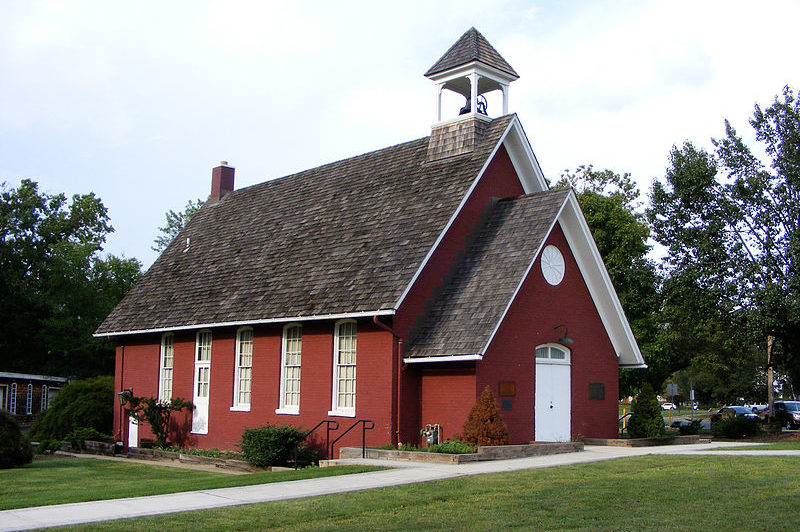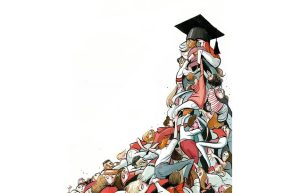Batavia, New York
I’m scribbling this on the porch as I stare at the chain-sawed remains of our massive and ancient (by American standards, which are the only standards I know) front-yard maple tree, which split in a windstorm and crushed my car. I had hoped to be a good custodian and pass along these sylvan sentinels intact to those who come after, but like America…well, I won’t go for a cheap and inexact analogy. Oh, 2020, you most annus horribilis.
But I am an inveterate looker-on-the-bright-side, and among the reasons for hope in this darksome time is the potential for new, or renewed, growth on the branches of the learning tree. (If I may borrow a line from the Jackson 5.
COVID-19, to give the devil his due, has thrown into jeopardy the big, impersonal education factory known as the American high school — a true midcentury modern atrocity. It doesn’t fit our don’t-stand-so-close-to-me moment (if I may borrow a line from the Police, who are yet to be defunded). So we may be in for a revival of the small, human-scale high school: that balm to the teenaged soul, that bane of 20th-century progressives and Cold War intellectuals.
The consolidation of small American school districts into bureaucratic agglomerations came in two waves. The first was launched during the Progressive Era, which also brought us Prohibition and World War One. That battle, as Jonathan Zimmerman wrote in The Little Red Schoolhouse in History and Memory, pitted rural people who ‘invoked classic themes of liberty and self-rule’ against ‘mostly urban elites’: those condescending busybodies ever occupied in making plans for Nigel (if I may borrow one from XTC).
Control of public schools was transferred from unlettered parents and upstanding citizens to professional educators enthroned in state capitals. These self-styled experts tended to be from state colleges of education, and their dire pronouncements on the quality of decentralized education were dutifully parroted by mass journals of opinion. The rubes and yokels, sighed the degreed class, were utterly incapable of self-government or oversight of their schools. Why, if left to their own devices, they’d be larnin’ their tykes that the earth is flat and babies come from storks.
The second and even deadlier wave of school consolidations arrived with the Cold War and was driven by the technocrats of the military-industrial complex (if I may borrow another, from President Eisenhower). Its chief propagandist was James Bryant Conant, the chemist and Harvard University president whose labors on behalf of humanity included participating in the Army’s Chemical Warfare Service in World War One and the Manhattan Project in World War Two.
In the late 1950s, Conant disgorged a series of Carnegie Commission-funded reports on the parlous state of American education. The problem, it seems, was that little Ivan Sputnik, in his regimented Soviet academy, was running rings around his slacker counterparts in the comparatively anarchic American system. The solution? Abolish all high schools with fewer than 400 students, demanded Conant, and do so by ‘compulsory measures’, not permitting parents or taxpayers a say in the matter. Those who disagreed, he sneered, were ‘living in imagination in a world which knew neither nuclear weapons nor Soviet imperialism’.
TIME, the New York Times, the Saturday Review, the ironically named Life… the stenographers of the American century adored Conant. Small schools and small districts were gobbled up wherever possible. Bigness was king.
Yet a cataract of evidence in the decades since has established the superiority of smaller districts and schools to the hypertrophied districts and the cold and crowded megaschools that Conant & Co. saddled us with. In our neck of the woods in Upstate New York, the late Thomas A. Lyson of Cornell, the dean of rural sociologists, found that ‘the social and economic welfare in all rural communities is higher in places that have schools’ than in those that lost their schools to consolidation.
Alas, the die was cast. The number of school districts in America freefell from 127,531 in 1931 to 17,995 in 1970 and fewer than 14,000 today.
Ah, but the COVID-induced fear of large indoor gatherings may force a salutary breakdown of American schools into more manageable and recognizably human forms which are constructed on a scale in which each kid matters. In the words of political scientist Frank Bryan, author of Real Democracy and one of seven members of the graduating class of 1959 at Newbury High School in Vermont, ‘Keep it small. The basketball isn’t good, but everybody gets to play.’
A school, whether consisting of one room or 20 rooms, ought to embody and reinforce a sense of place. The thousand-plus-student widget factories of the pre-COVID USA belong in the Cold War garbage dump with loyalty oaths and the metric system. It’s long past time to carve ‘em into pieces. Fire up those chain saws, boys.
Postscript. I’m afraid I won’t be joining the chainsaw brigade. Several days later, I was helping a neighbor load those massive chain-sawed logs into a bucket when one slipped and almost crushed my left hand. Broke two fingers and required 20-something stitches. Still hurts like hell, though my one-handed hunt-and-peck typing is improving. On the bright side, I can tell people I was injured in a ‘logging accident’.
This article was originally published in The Spectator’s November 2020 US edition.


















